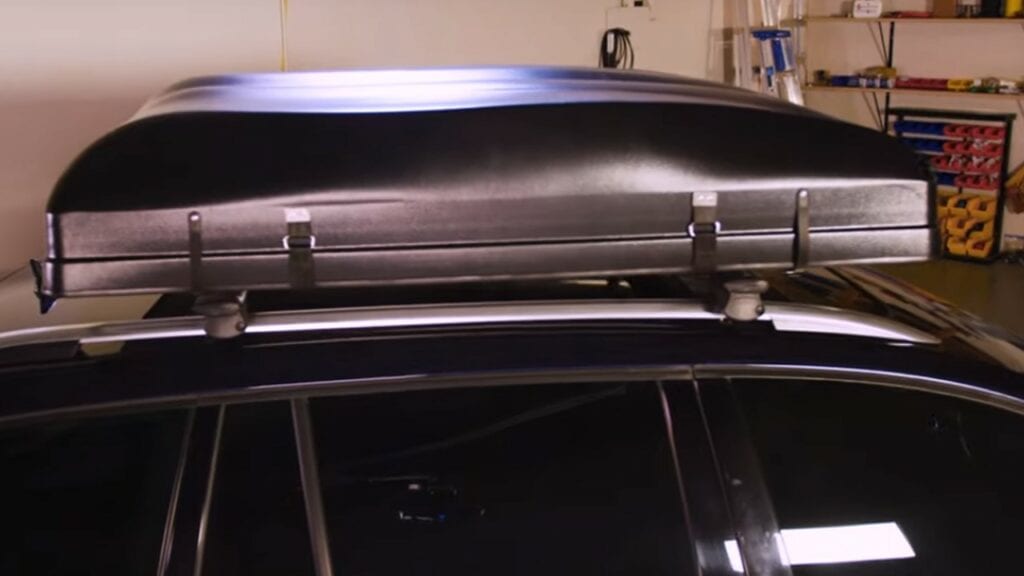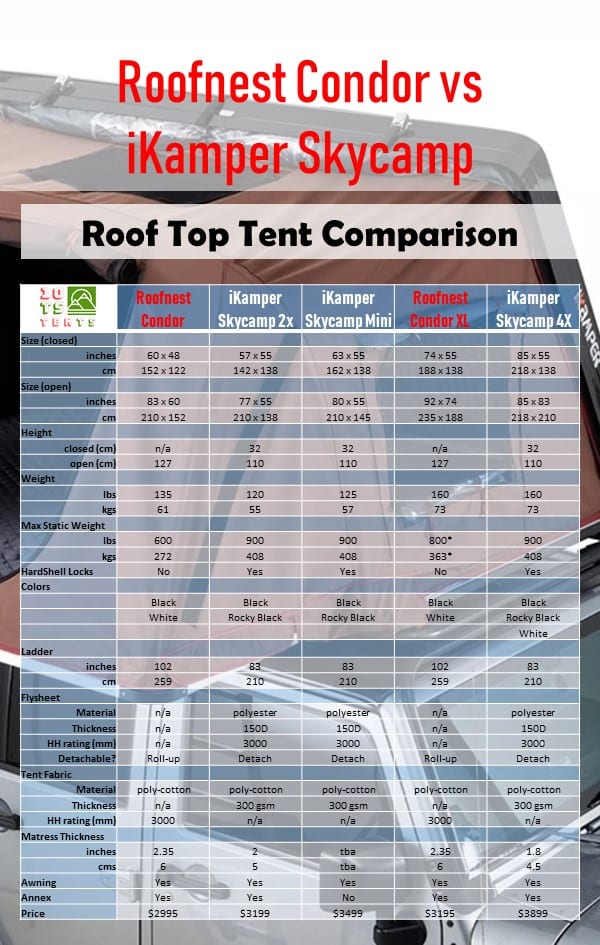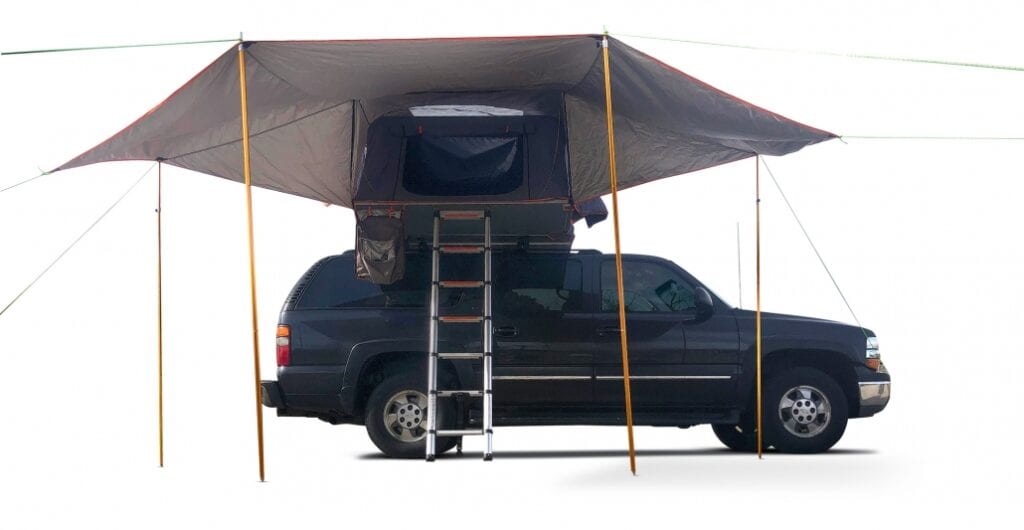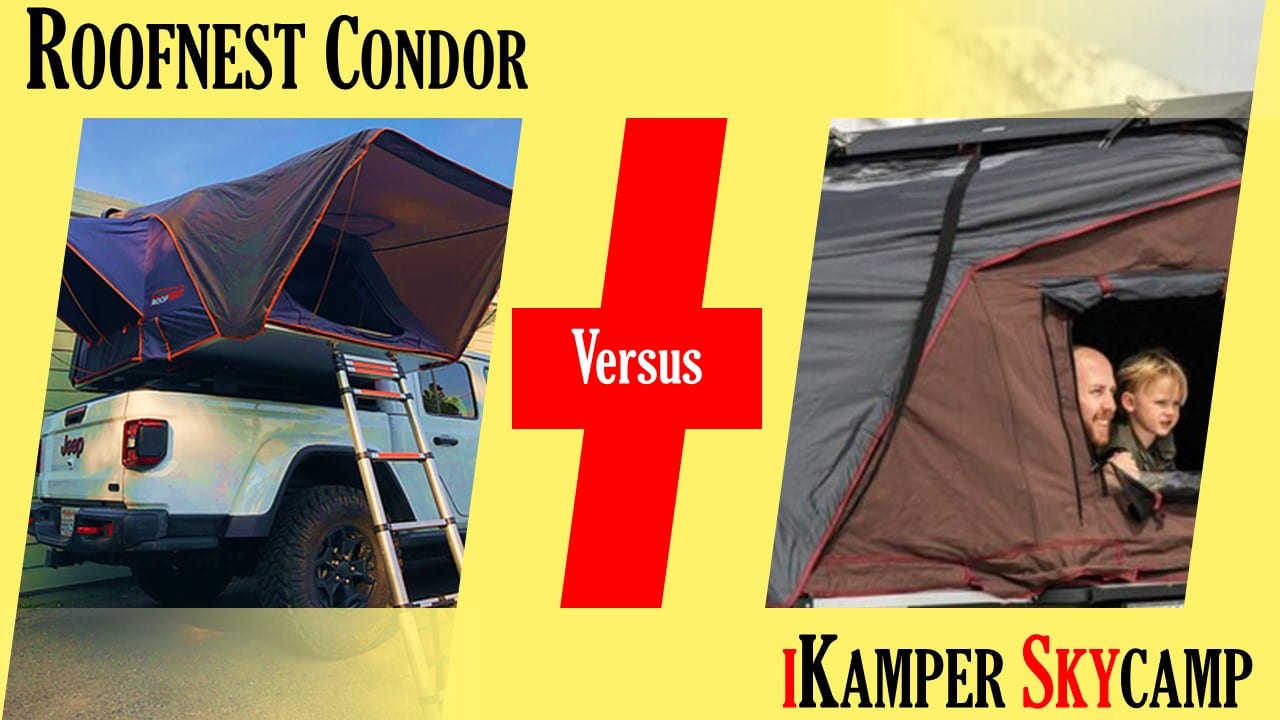When I reviewed the iKamper 2.0, I said, that the only copycat I would ever consider was the Roofnest Condor.
And indeed: Roofnest have been earning a name and have been on the market with quality, reliable roof top tents for a few years now. The Roofnest Condor, despite being the only hybrid roof tent in the Roofnest range, fits perfectly in the line of affordable, decent roof top tents.
I don’t want to go into the debate of whether or not it is a straight rip off of the design of the Skycamp: there are a lot of similarities, that’s for sure. And although the apple doesn’t fall far from the tree, there are a lot of differences as well.
So in this review of the Roofnest Condor, I shed light upon those differences.
To make it more complicated, the Roofnest Condors come in two sizes, Condor and Condor XL; while we have three iKampers: iKamper Skycamp 2x, Mini and 2.0 (4x).
The Roofnest Condor in reality, must be compared to the iKamper Skycamp 2X and the Skycamp Mini.
The Roofnest Condor XL is comparable to the iKamper Skycamp 4X 2.0.
I have therefore made a comparison table, that makes it easier to see the differences right away. I’ll focus this post on the Condor and the Condor XL, highlighting the differences to their iKamper counterpart.
If you are looking for a detailed review on the iKamper Skycamp roof tents, you can find the review on Skycamp 2X here, the review on the Skycamp 4X 2.0 here; plus a detailed comparison between the iKamper X-Cover and the Skycamp 2.0 here.
In this post:
- Who are the Roofnest Condors for?
- First Look
- Fitting / weight and pitching
- Inside the Roofnest Condors
- Weather Protection
- Accessories
- Roofnest Condor vs iKamper Skycamp – Verdict
Roofnest vs iKamper – Quick Summary
The Condors are not without flaws, and although you are probably best brace yourself for a bit of compromise, they are not bad tents. The iKampers aren’t perfect either… The pitching / packing away the Roofnest Condor is not that smart and seamless as the Skycamps’ well-though-out process, but in return, you have HUGE interior space and 2 sky windows.
Even if they cost the same, I would seriously consider the Roofnest over the iKamper…but the Roofnest Condors are almost a category cheaper than the iKamper Skycamps. So if your after value for the price you pay, there should not be a lot of questions about which one to pick…Unless, you live outside the US…
Roofnest Condor – What is it and who is it for?
As I said, the Condor and the Condor XL are the only hybrid roof top tent by Roofnest, but they are the largest too. The Roofnest Condor XL is a 4-person rooftent that fits on most cars from smaller sedans / estates upwards, it’s easy to pop up and has good all-round weather protection. Overlanding is a smooth experience with the Roofnest Condor XL. Paired it with the size the Condor XL offers, it can be an ideal family rooftent or a proper expedition rooftent for hardcore overlanders as well. The same is true for the smaller Condor as well, which has a decent size for a smaller family or couples.
About Roofnest
Roofnest was founded by an Alaskan guy called Tim Nickles. He lives now in Colorado and that’s where Roofnest are based. The idea of Roofnest came from camping with friends and Tim’s obsession with gear and camping tech, adventures and exploration. Roofnest are a fairly new company (I could not find any info about the year it was founded in).
Roofnest are aiming to make the roof top experience available to as many people as possible. They structured their company to keep their overhead costs low and sell Roofnests directly to the customer, so they can keep their prices low.
The Roofnests are manufactured in China. Having said that, it is not necessarily a bad thing, as long as quality control in the US do their job. They have a warehouse in Boulder, CO and in Dorchester (UK).
First look
The Roofnest Condors come in black or white, but this is the shiny version: there is not a matte black color option for them.
Compared with the Roofnest tents, the Skycamp 2.0 has the widest range of options when it comes to picking a color: it has three different colors: black, rocky black and white. So if you like black you have plenty of choice 🙂 The Skycamp 2.0 actually looks quite modern, it has a nice, streamlined shape when closed, that helps reducing wind-noise during transport and it has better miles to the gallon. Rocky black is the rugged, non-shiny black.

Roofnest Condor shiny black hard top – Streamlined but looks a bit bulky. I preferred the look of the Skycamp
The smaller iKampers, the 2x and the Mini come in black or rocky black only, there is no white version of them
In terms of size when packed up, the Roofnest Condors are slightly more compact than their iKamper counterpart. Despite the similarities in the way they fold out, the mechanism is slightly different that allows them to fold into a smaller space.
Roofnest Condor vs Skycamp 2x/Mini
The Condor comes in an only 122 cms / 48 inches wide streamlined hardshell box, while the Skycamps are 138 cms / 55 inches wide, with respective length of 57 and 63 inches for the 2X / mini.
When the are folded out, the difference in size is even more apparent.
The iKamper Skycamp 2X is the red herring, as you sleep back/front. All the other rooftents designed to allow people to sleep right / left, with your feet towards the entrance / exit.
This means that the iKamper Skycamp 2x is the smallest of the three, providing space for two people on a 210 x 138 cm footprint.
The Skycamp Mini is slightly bigger, 145 cms wide; while the Condor is 152 cms wide. Small differences, but that 15 cms difference between the Roofnest Condor vs the Skycamp 2x can make a lot of impact on your comfort level, especially if you travel with a 3rd companion.
But the biggest difference is in the height: the Condor’s 127 cm height when open is simply another level, compared to the 110 cms of the Skycamps.
Condor XL vs Skycamp 4x
Slightly different scenario here. The Condor XL is compact: shorter than the Skycamp 4x and spot on the same width when packed up.
On the other hand, (much) longer and a tiny bit narrower than the Skycamp 2.0 when folded out. The difference in height is the same here, 127 cms compared to 110 cms.
There is no information on the height of the profile of the Roofnest Condors, however they are not excessively high and the shell is shaped to reduce and minimise wind drag / wind noise, also supporting minimal increase in mpg.
Fitting, Weight & Pitching
The lightest of the 5 is the Skycamp 2x (no surprise, it is the smallest…), but there is no big difference.
The Condor XL and the Skycamp 4x have identical weight, just under 75 kgs / 165 lbs but in my opinion, just over the weight where you could fit them onto a normal car with 165 lbs roof load capacity without concerns – with the weight of the crossbars you’ll likely exceed the car manufacturer’s recommended roof load weight.
The smaller Condor is slightly heavier than the small iKampers, and again: my wife’s car for example has a 60kg maximum roof load weight capacity. I could confidently install the Skycamp 2x on top of it, but the Condor with it’s 61 kgs net weight would not be safe in my opinion.
Related post: Roof Top Tent Weight Limits
As for fitting, there is no major difference. What you must make sure that you follow the instructions when it comes to installing your roof tent. Roofnest has some recommendation and limits on the distance between the crossbars and suggests you use 3 for the Condor XL for optimal weight distribution.

Roofnest Condor fitting
Pitching-wise all 5 are very easy to fold out. The iKamper Skycamps literally take a minute to set up: you just unlock the hard shell, pop it up and the gas assisted struts push the lid into position.

Latches secure the hard-shell of the Roofnest Condor. iKamper’s solution is a bit more sophisticated
The Roofnest Condor and Condor XL open very similarly, using the same mechanism with 1 BIG DIFFERENCE.
While the flysheet on the Skycamps is fixed to the tent as default (albeit completely removable), and therefore it is in position when you open the tent up. The flysheet on the Condors is rolled up / loose as default.
This means that you need to climb into the tent, open the roof window, untie the rolled up flysheet and roll it down.
This guy explains it really well in this video, so pay attention to the details (source: https://roofnest.com/product/condor/)
It is not a big issue, but it seems to me that it’s not as well thought out as the iKampers set-up.
When it becomes a big issue is when packing the roof tent away.
The process is reverse, you need to roll up the flysheet on the Condor and Condor XL, tie them, climb out and then you can start folding the tent…
As I said, you’d have no issues like this on the iKampers, taking them away takes 90 seconds. It takes considerably more time to pack the Roofnest Condors away.
Inside the Roofnest Condors
Space
The real strength of the Roofnest Condors is the huge interior space.
I mentioned that they are almost a head higher than the Skycamps, that already makes a huge difference.
The Condor is wider than the Skycamp 2x or the Skycamp Mini. The Condor XL is much longer than the Skycamp 4x. The Condors are simply HUGE.

Skywindows – there are 2 of them on the Roofnest Condors


Skycamp interiors – the pattern inner cover is a nice touch
And the Roofnest Condors feel even larger thanks to the plenty of light the 2 roof windows let in! (The Skycamps have only one roof window).
Getting in and out
All roof tents come with a telescopic alu-ladder. There are a few differences though.
Length: the Skycamps have a relatively short ladder as default, you need to buy ladder extension if you need them to be longer than 210 cms / 83 inches. Though it seems adequate, in reality, if you have a larger car you won’t be able to maintain an angle that is comfortable and safe to access / egress.
Nice touch, on the other hand, that the steps are angled, so it’s less painful to climb the ladders bare-feet.
The Condors come equipped with a very long ladder: 260 cms /102″ is more than plenty. There may be two issues with it: if you have smaller car, the better part of the telescopic ladder will remain collapsed, which virtually means ‘no steps’.
The other issue with the ladder on the Condors is the angle. Especially on the Condor XL, that is much longer than the Skycamp 4X, the ladder supports the aluminium frame when folded out. Therefore, you need to keep the ladder close to an upright position, which is makes getting in and out a bit awkward.
The steps are not angled either, but since yo keep the whole ladder almost vertical, it’s not that big of an issue.
Mattress
The mattress the Condors use is slightly thicker than the ones in the Skycamps. 2.35 inches is not a lot, but you also get a free anti-condensation mat with the Condor and the Condor XL.
The mattress cover is removable that makes it easy to clean. The actual size of the mattress is (always) slightly less than the inner width of the tent. The Roofnest Condor for example, has a 80″ by 57″ mattress inside a 83″ by 60″ tent.


Weight Limit
I don’t normally pay attention to the static weight limit of a roof tent, as I naturally suppose that it can bear the weight of the people who would sleep in it. (Don’t confuse the static weight limit with the dynamic load limit, the latter is important when the tent is in transport, and it’s for the vehicle, while the former is the weight that the roof tent setup can hold when fully pitched).
Not the case with the Roofnest Condor XL, hence – according to the website – the weight limit of the Condor XL is 600 lbs / 272 kgs. I thought, that’s a bit slim, as 4 people are supposed to be able to sleep in the Condor XL. That’s 4 adults, averaging 68kgs. Not sure…
I had to ask Roofnest directly to confirm the weight limit of the Roofnest Condor XL, and according to Ross, it’s 800 lbs / 363 kgs. Which is much better, and this limit now is comfortably over the weight of 4 adults.
Having said that, the Skycamps have a 900lbs / 408kgs weight limit.
Weather Protection
As for protection from water, none of the 5 roof tents lack the necessary means to keep rainwater out.
The Skycamps have a 150D, 3000mm HH polyester flysheet over the poly-cotton tent which will keep water out for sure, but as I said in the detailed reviews, it may increase condensation inside the tent (and between the flysheet and the tent).
Luckily, the flysheet is removable so you can dry it out properly.
Sadly, we have no information on the material of the flysheet of the Roofnest Condors. What we know, is that the tent wall is made of poly-cotton and has a 3000mm HH waterproof rating. So, in theory, the Condors are waterproof without the flysheet. I just don’t know why you’d need a flysheet then…
If you are interested what it all means, what are the pros and cons of different tent fabrics, have a look at here:
Tent materials, fabrics, specifications and all the acronyms. FAQ.
As with all poly-cotton tents, you need to weather the fabric before the first use, to allow the cotton fibres to swell up.
The fabric insulation inside the hard-shell on the Condors is a niche touch, but the iKampers have nice fabrics inside too, as well as a double layer lid to further improve insulation.

Roofnext Condor v iKamper Skycamp detailed comparison
Accessories, upgrades
There are a few upgrades / accessories. The Condor Awning for example comes in two sizes, one for the Condor and one for the Condor XL, and is great for keeping your entire camp space dry and shaded.
It zips directly into the flysheet on the Condor and is supported by 4 sturdy adjustable aluminum poles with tie-downs. The material is UV treated 420D polyester.
There is also an Annex available for both the Condor and the Condor XL. They zip directly into the flysheet. The Annex has three zip up entrances with bug mesh and tent material and 2 windows which provide great natural light. Set up time is around 10 minutes.
The annex is made of 280g poly cotton and has an antimicrobial waterproof silver coating – the silver coating reflect sunlight to increase protection from UV rays and help keep the annex cool in the summer.

Roofnest Condor with Awning
The Condor Annex Regular is 73″ wide by 102″ long and is 104″ tall, the XL is 102″ wide by 112″ long and is 104″ tall. Neither of them has groundsheet. The height is fixed, so with a smaller car the skirting would look funny, with a higher car it may not reach the ground. It’s definitely worth a try before buying, or ask about the return options before buying it, in case the annex would not fit your car.
The iKampers ‘traditionally’ have a lot of accessories available, though many of them are items provided for free by other manufacturers. What you definitely can’t have with your Roofnest Condors is the inner insulation, that is only available for the iKamper Skycamp 4X and Skycamp Mini.
On the other hand, you can add Annex to the 2X and the 4x, not to the Mini. So it’s a bit of a mix, it’s not easy to pick the Skycamp that is perfect from every aspect…
Roofnest Condor vs iKamper Skycamp – Verdict & Price
Although the Condors are not perfect, and you are probably best brace yourself for a bit of compromise, they are not bad tents. The iKampers aren’t perfect either…
The pitching / packing away the Roofnest Condor is not that smart and seamless as the Skycamps’ well-though-out process, but in return, you have HUGE interior space and 2 sky windows.
Even if they cost the same, I would seriously consider the Roofnest over the iKamper…
Price
But in terms of price, even the cheapest, smallest iKamper Skycamp, the 2x is slightly more expensive than the larger Roofnest Condor.
And to be honest, at the time I checked the price on iKampers website, the $3199 version shiny black Skycamp 2x wasn’t even available, so the cheapest I could have got was the Rocky Black Skycamp 2x for $3499…vs. the £3195 + free delivery price of the Roofnest Condor XL
It’s quite a big difference, especially if you bear in mind how much bigger the Condor XL is, than the Skycamp 4X, yet alone the others. The Price / Value – compared to the iKamper Skycamp – is amazing.
It only gets slightly trickier when you live outside the US: the Condor is not (yet) available in the UK for example. So dear UK readers, you either keep bombarding info@roofnest.co.uk with emails that you WANT the Roofnest Condor, or stick with a Skycamp…
I nicked some pictures from Jeep Gladiator Forum

Thanks for doing this detailed comparison! The Skycamp, Condor XL, Torro SkyLux, and TuffStuff Alpha all appear similar, and your review is the first I have seen to dive into the differences.
Hi Chris,
Thanks for you comment! Yes, it’s a pretty competitive segment, and by the looks of it, Skycamp really hit the nail on the head with the design!
I am just a bit afraid that we’ll see the copycats appear on AliBaba – unbranded, and suddenly everyone will have a ‘similar’ design RTT…
Hey Greg,
Reviews like yours will help us separate the quality tents from the rest. Two quick clarification questions:
– The Condor XL looks a foot shorter while closed than the Skycamp 4x, so that means less overhang for smaller vehicles and installation over short truck beds?
– Is there a way to open the Condor models with the fly sheet attached for users in the rainy PNW, or is that a specific advantage to iKamper?
Hi Chris,
Thanks for your comment:
Yes, the Condor XL is shorter and also, it is symmetric (entrance can be on either side of the truck), if it matters at all. The iKamper has lower profile on one end, designed to have the entrance on the right-hand side of the vehicle. But it probably does not make any difference when you put it on the truck bed.
The rainfly on the condor XL, when rolled out, connects to the little clamps at the bottom of the baseplate. You can unclip it, letting it hanging loose before closing the lid, but it is going to be a bit of a struggle tucking it all in.
But to be fair, the tent wall is made of polycotton, which is waterproof anyways. The only advantage the rainfly may have, is that it dries quicker.
Hope this helps
Thanks for this comparison. It helped a lot, at first I was dead set on the Condor XL but even though it can be had for 1000$ or so less, and comes with a few extra perks like the bags, interior pockets, lights, and thicker mattress. It has a few things that may be long term deal killers for me when I plan to have this for the long haul… until it falls apart.
The side windows of the Roofnest can’t be rolled up unless you modified he tent. The awnings are either up or not. And of I out it on a low rack above a truck bed, the window by the cab won’t be able to use the awning poles.
The latch system is by far better on the iKamper, it’s not even close. iKamper won’t sell them either, I asked.
Mounting clamps on the iKamper are way better. Those can be bought, around $100.
There are companies that will do 10% off iKamper and are authorized dealers. So now the price is 3200 vs 3510 for black, a bit more for rocky black on iKamper. At that difference, I’m leaning back towards iKamper.
I mentioned the mattress, and that’s a big deal. I’ve slept in the iKamper, the mattress is terrible for side sleepers, just awful. But, we already have a self inflating 4″ from tent camping that will just go up there at night and pack away when we leave since I’m pretty sure it won’t fit closed.
Thanks for the extra info
Does the Condor or Condor XL allow for storing of bedding in the tent? The Skycamp is very tight and does not allow much to be stored in it.
Hi James,
That’s the limitation of the three-fold design…:(
~Anyone dare buy the Roofnest Sparrow/Condor & put ikamper bracket/backet lock on it? If so, how did that go?
Seems to me that’s the advantage of going with ikamper as I’m trying to find a RTT has some lock security built into it: at the shell, at the bracket like ikamper does.
I have a condor xl. I don’t see what you’re talking about the detachment and rolling up of the rain fly before folding it to put away. Must’ve been an older design. Mine rain fly is attached to the bottom with velcro and it opens and folds away with the rainfly still attached with no issue. The same tucking of the sides is needed just like I see done on the ikamps as well. I leave my pillows and blankets in my condor xl when I fold it away.